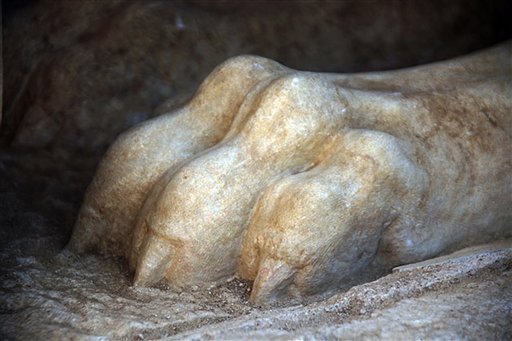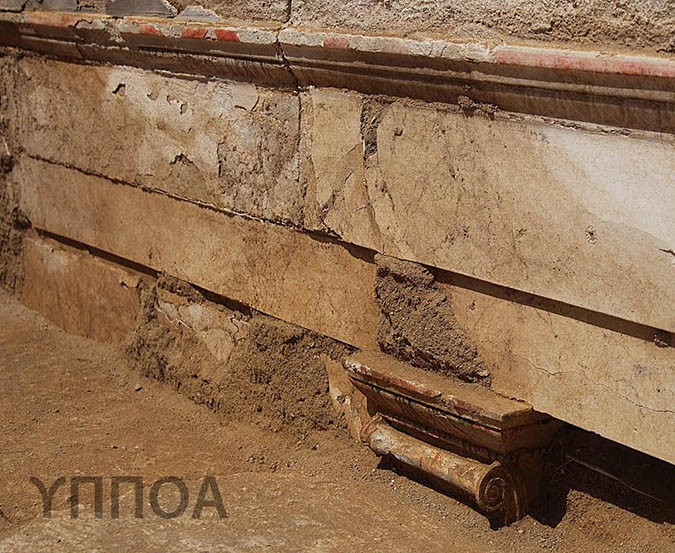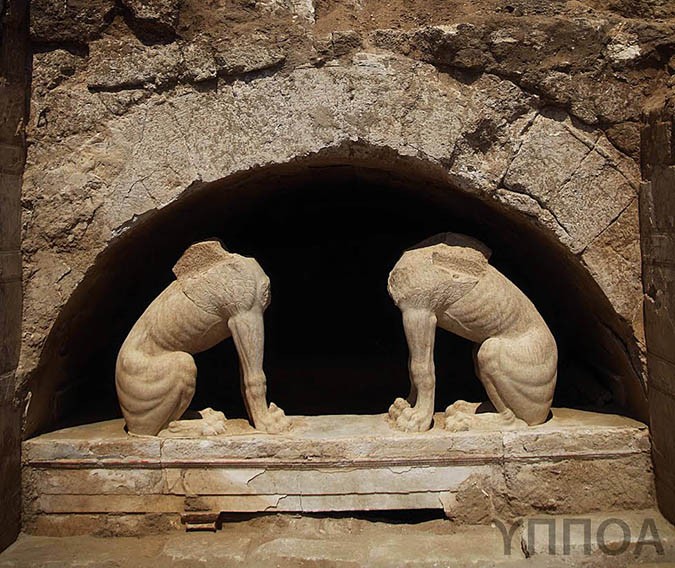The Culture Ministry appealed on Thursday for people to show “understanding” as the excavation of the burial mound that has propelled international interest continues at ancient Amphipolis. The partially uncovered tomb so far has revealed the tomb’s entrance with the two headless sphinxes – originally two meters high under a barrel-vaulted roof and a doorway covered with traces of painted plaster decoration. A crane was used to gently remove the brittle limestone blocks barring the access to the inner tomb and a diamond-pattern floor mosaic was detected.
Two meters under the debris from behind the sphinx guards of the tomb an upper register of a marble lintel with frescoes was revealed at the base. The lintel is an imitation of an Ionic lintel (epistyle) with traces of paint colored red, blue and black. It rests on two Ionic capitals with traces of the same colors that crown the pillasters that form the door frame. The archaeological service is continuing the removal of the earth around the apse and the stones of the protecting wall below it, while Friday’s work will include stabilising Thursday’s findings. It has also been announced that the Hellenic Gas Transmission System S.A. (DESFA) is giving 30,000 euros for the excavation work to continue in this area.
What archaeologists have found so far:
* Two headless and wingless sphinxes placed on a lintel just under a barrel-vaulted roof with traces of red paint on their feet.
* Parts of the wings were found
* A doorway covered in earth, with traces of painted plaster decoration of red, black and blue in lintel that mimics an ionic lintel (epistyle) and rests on two Ionic capitals painted with the same colors, crowning the pillasters that form the door frame
* A diamond-patterned floor mosaic is at the entrance of the tomb
* Part of the back of a five-meter marble lion on a nearby road originally topped the tomb
* The two sphinxes and the Lion of Amphipolis were made in the same workshop
The owner
The tomb is dated to be from the end of Alexander the Great’s reign. The great warrior-king died in Babylon in 323 B.C. aged 33 and was buried in Egypt. His grave has yet to be found, but archaeologists rule out that the grave at Amphipolis could belong to him though it is the biggest tomb from antiquity found in Greece as yet. Archaeologists estimate that it was a hugely costly monument at the time, ascertaining that somebody important is buried there.
It is expected that somebody close to Alexander the Great is buried in the tomb. Alexander’s mother, widow, son, brother and sister-in-law were all murdered around the area during cut-throat power struggles for leadership following his death. Royals, however, were traditionally buried at Aegae where spectacular graves excavated in the late Seventies revealed the resting place of Philip II, Alexander’s father, and a son. Even so, archaeologists haven’t ruled out that a member of his family may be buried here.
The lion statue, believed to have stood at the top of the grave, was linked in older research with Laomedon, a military commander and friend of Alexander. Archaeology professor Michalis Tiverios says that Nearchus, one of Alexander’s admirals, who lived in Amphipolis is also a likely candidate. The lion statue atop the tomb indicates that the monument likely belongs to a male figure who is likely associated with battles from the era. Tiverios, like archaeologist Petros Themelis, believes taht the monument could also contain several Macedonian warriors or may be a cenotaph. (CLICK HERE for more information about this theory)
Looting
There is fear that the tomb may have been looted hundreds of years ago as part of a stone wall that blocked off the subterranean entrance is missing and the sphinxes lack heads and wings.The lion had been removed in Roman times and the burial mound was known back then.
Most of the 600 locals at the nearby villages of Amphipolis and Mesolakia have a tale to tell about smugglers stating that they have often seen people with lanterns on the hill searching. Infact, it was commonly known that something of value was located at the site decades before excavations officially began in 2012.
Police have made dozens of arrests for antique smoggling in the area over the last few years, including a case of an elaborate gold funerary wreath allegedly found by a farmer in the early Nineties and sold to the J. Paul Getty Museum in Los Angeles for $1.15 million. The wreath was returned to Greece in 2007 after a 10-year legal battle.
The excavation is expected to last another few weeks. Footage from the excavation site on Thursday –










































